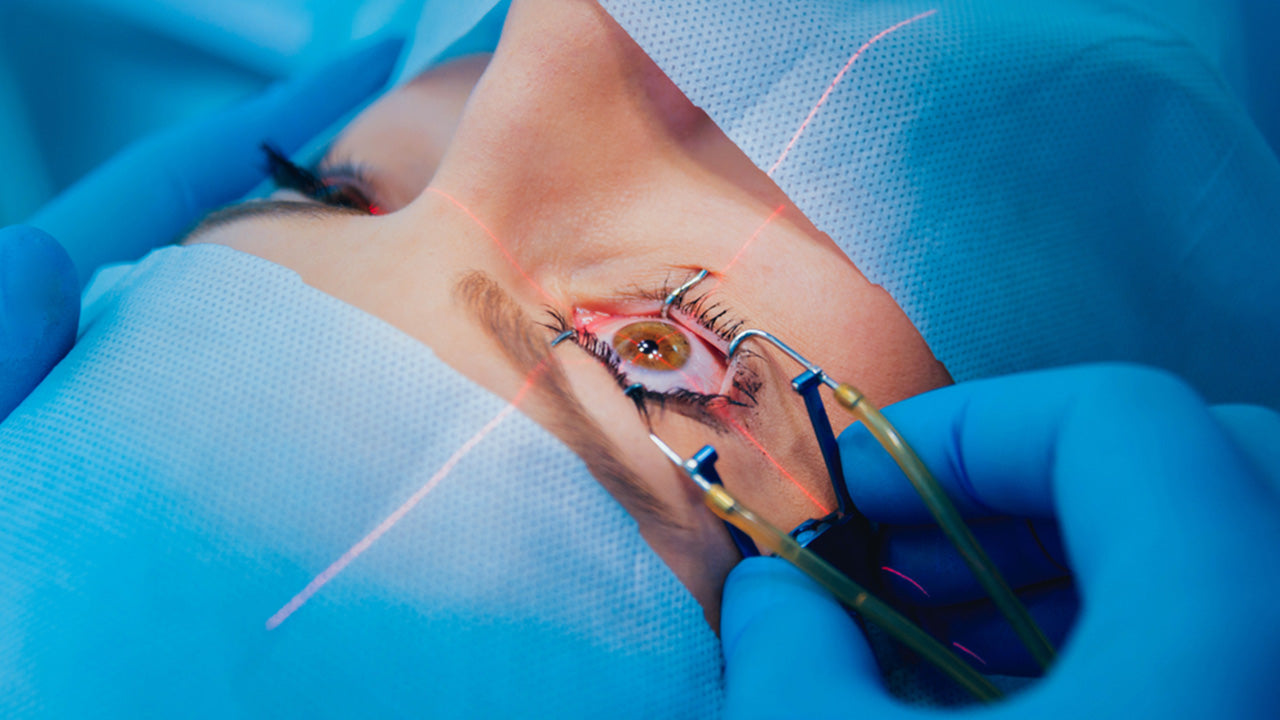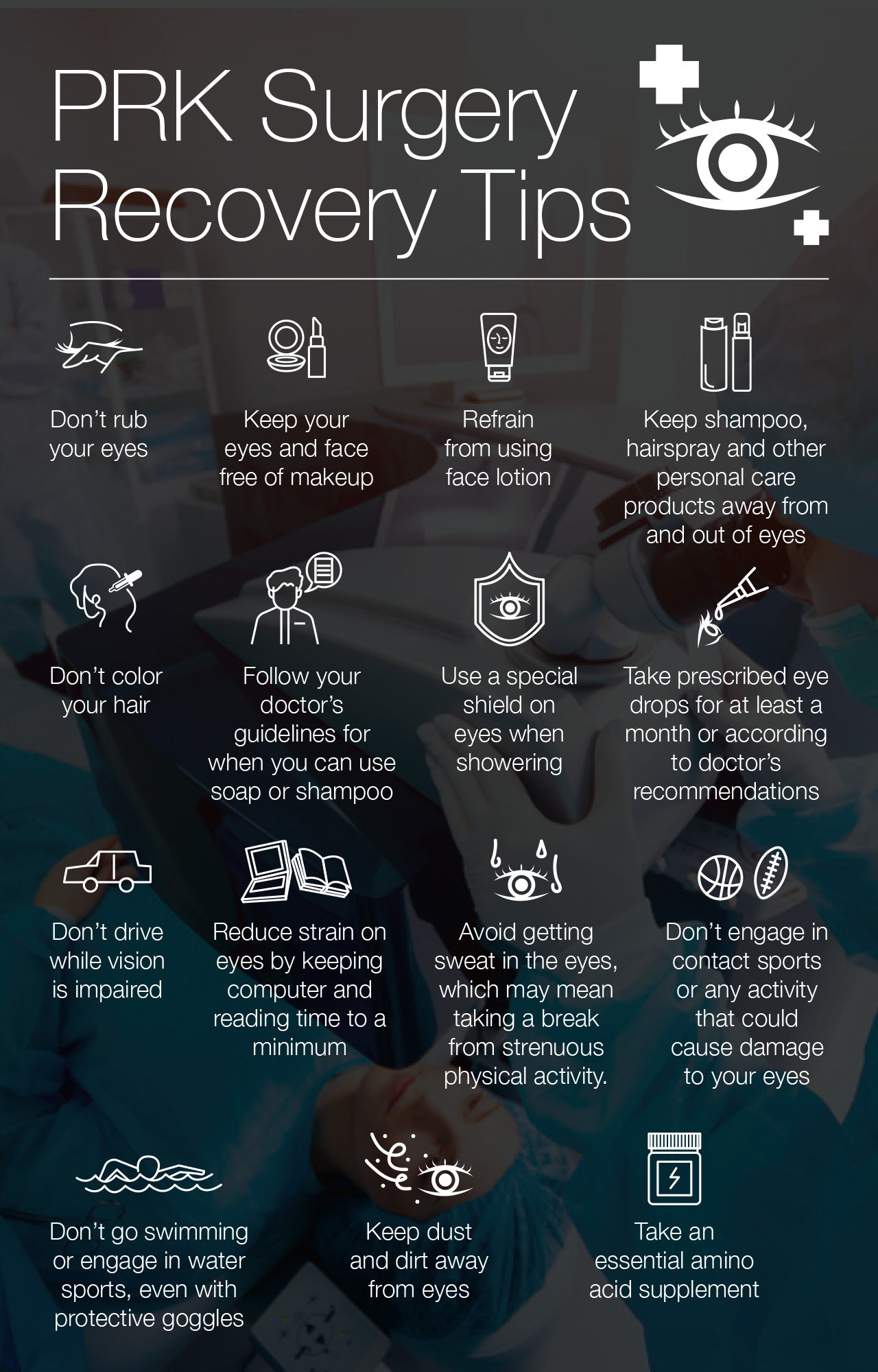PRK Recovery Timeline: How Long Before You Start Seeing Better?
 By: by Amino Science
By: by Amino Science

If you’re in the market for better vision, photorefractive keratectomy (PRK) surgery may be on the docket. Learn all about PRK surgery for vision correction, how it differs from LASIK, what to expect, and the PRK recovery timeline.
What Is PRK?
PRK laser vision correction improves vision by rectifying refractive errors in the eye such as nearsightedness, farsightedness, and astigmatism. The cost varies depending on doctor, location, and need, but typically ranges between $1800 and $4000.
PRK vs. LASIK
Before LASIK surgery, there was PRK, and it might still be the better option for your eye(s).
Both PRK and LASIK eye surgeries use lasers to reshape the cornea, which is the transparent outer layer at the front of the eye that helps your eye focus light so you can see clearly. Although the PRK recovery timeline is longer and the discomfort greater, the success rate is similar, and it is the more suitable of the surgeries for people with thin corneas or extremely poor vision.
During a PRK procedure, the ophthalmologist extracts the cornea’s outer epithelial layer before reshaping the cornea. The layer regenerates overtime.
During a LASIK procedure, the ophthalmologist uses a bladeless laser to form a flap from the epithelial layer that is pulled back as the cornea is reshaped underneath and then repositioned onto the cornea.
The LASIK recovery period is faster than the PRK recovery timeline, with less discomfort or visual acuity side effects, but you have to have an adequate amount of corneal tissue to be a good candidate for LASIK.
Success rates are similar, so if it’s better vision you’re after, don’t be too disappointed if your eye doctor advises you to get PRK instead of LASIK. According to studies, after 1 month, 80% of PRK patients have improved vision and by 3 months, 95% have improved vision. Improvements range between 20/30 and 20/50, with 92% of PRK patients achieving 20/40 vision or better and no longer in need of glasses or contacts.
What to Expect Before the Procedure
At your pre-op appointment your doctor will check your vision and test your eyes, measuring the refractive error and pupil, mapping the corneal shape, and programing improvements into a laser that will be used during the procedure.
Your doctor will provide you with a complete list of pre-surgery guidelines. Be sure to discuss any medications you are currently taking with your doctor to check for contraindications, such as antihistamines, which surgeons typically advise discontinuing 3 days prior to surgery.
Anticipate not being able to wear your contact lenses a week before surgery, and 3 weeks before surgery If you wear rigid gas permeable contact lenses.
Your doctor may prescribe an antibiotic eye drop called Zymaxid to begin taking 3 to 4 days before your vision correction surgery and up to a week after your procedure along with eye drops for dry eye.
Your ophthalmologist may also recommend a twice-a-day cleaning regimen to begin 3 days before your procedure to flush out the oil glands around the lash line.
- Put a warm compress on your eye for 5 minutes.
- Starting at the inner corner of your upper eyelid, run your finger along the eyelid 2-3 times. Repeat on the lower eyelid.
- Clean your eyelids with a gentle soap.
Pre-op Checklist
- Do you have transportation to and from your doctor's office the day of surgery and someone to make sure you’re comfortable when you return home?
- Do you have comfy clothes laid out and ready to go?
- Is your face clean and makeup free?
- Have you removed all accessories, like earrings and scarves that can get in your surgeon’s way?
- Do you have over-the-counter pain meds to help with discomfort?
- Have you ordered the necessary supplies, such as eye drops or other pain medications?
- Have you contacted your place of work and requested the appropriate time off (a week to 10 days)?
What to Expect During the Procedure
PRK surgery itself takes a mere 5-10 minutes to perform under local anesthesia or with the application of numbing eye drops, but anticipate being at the clinic for a few hours from start to finish.
Your doctor will place a lid speculum on the eyes to keep them open. While you look at a target light, your surgeon will direct the excimer laser, which was programmed with your precise prescription during your preoperative appointment, to send pulses of light to your cornea, removing microscopic amounts of tissue and reshaping the cornea.
You’ll hear the beep of the laser and you may feel pressure, but most people don’t report feeling pain.
After reshaping your cornea, the surgeon will cover it with a bandage contact lens to help it heal and prevent infection. Over the next few days, epithelial cells will regenerate and in 5-7 days you’ll return to the clinic to have your bandage contact removed.
What to Expect After the Procedure
After the procedure you’ll rest at the clinic before returning home, where you’ll rest some more. Follow your eye surgeon's orders to rest on the first day and for a few days after, avoiding screen time. That means no computers or television or reading, and certainly no driving for the first week.
Keeping your eyes closed will help to speed recovery and placate discomfort.
The first few days after the procedure expect to feel some pain, which can be managed with over-the-counter analgesics. Doctors typically do not prescribe painkillers for PRK surgery, as any discomfort should start subsiding by day 4. If it does not, then a followup conversation or appointment is warranted.
Post surgery it is normal to experience:
- Itching eyes
- Watering eyes
- Irritated eyes
- Burning or dry eyes
- Feeling like something is in the eye
- Sensitivity to light
- Halos or bursts of light
- Corneal haze (blurred vision)
If you experience any of the following side effects, contact your doctor:
- Redness
- Swelling
- Pus
- Fever
- Dislodged or removed bandage contact lens
Expect your vision to initially improve, but then become blurry or impaired in the days following until the bandage contact lenses are removed. Do not worry! Full restoration can take between 3 and 6 months.
PRK Recovery Timeline
For the first week after surgery, follow these tips to speed the healing process and protect your eye health.
- Don’t rub your eyes
- Keep your eyes and face free of makeup
- Refrain from using face lotion
- Keep shampoo, hairspray, and other personal care products away from and out of eyes
- Don’t color your hair
- Follow your doctor’s guidelines for when you can use soap or shampoo
- Use a special shield on eyes when showering
- Take prescribed eye drops for at least a month or according to doctor recommendations
- Don’t drive while vision is impaired
- Reduce strain on eyes by keeping computer and reading time to a minimum
- Avoid getting sweat in the eyes, which may mean taking a break from strenuous physical activity.
- Don’t engage in contact sports or any activity that could cause damage to your eyes
- Don’t go swimming or engage in water sports, even with protective goggles
- Keep dust and dirt away from eyes
We’ve already covered what to expect the first several days after surgery: some discomfort and irritability in the eyes as well as blurred or hazy vision. Let’s run through what to expect in the days and months that follow.
Days 5-7
As soon as 5 days post-op the bandage contact lenses can come off. Healing begins from the outer layer of the cornea to the center of the eye, so it is normal to see a tiny ridge of epithelial tissue across the pupil.
Weeks 1-4
After the first week you should be cleared for driving and work. Pain and discomfort should have subsided along with other side effects. There may still be issues with visual acuity, including:
- Halos
- Starbursts
- Glares
- Impaired night vision
Weeks 4-6
You should see marked improvement to your vision after the first month. To decrease the risk of corneal haze, continue using any prescribed eye drops as well as drops for dry eye if it occurs. Other visual side effects such as light sensitivity and glares will begin to subside.
Months 3-6
You can expect that 20/40 improvement to vision at the 3- to 6-month mark.
1 Year
By 6 months to a year you can expect to see the full benefit of your PRK surgery, and patients can often stop wearing their eyeglasses and contact lenses.
It’s important during that first year to protect your eyes from ultraviolet radiation and wear anti-glare sunglasses. This is because your lens may take some time to adjust to bright lights. Anti-glare glasses can also help if you spend a significant amount of time staring at a bright computer screen.

Are There Risks to PRK Surgery?
As with other types of laser eye surgery there are risks to PRK. We encourage you to speak with your ophthalmologist about complications, including:
- Permanent vision loss
- Permanent vision impairments, such as glares and halos
- Double vision
- Severe or permanent dry eye
- Declining results over time in farsighted or elderly individuals
Healing Quicker with Amino Acid Supplements
Along with rest and minimizing eye strain, you can accelerate the recovery process by taking amino acid supplements, as evidenced by a study published in the Journal of Refractive Surgery.
Researchers examined the effects of amino acid supplements on corneal healing after refractive surgery and found that patients taking amino acids showed greater improvement in re-epithelialization, indicating accelerated healing.
Countless studies have shown that supplementing with essential amino acids pre and post many different types of surgery helps to speed recovery time and decrease the risk of infection, which is why Amino Co developed a specific blend of amino acids called Heal.
If you are considering PRK surgery, then click here to learn more about the power of essential amino acids to quicken your PRK recovery timeline.

Up to 25% off Amino
Shop NowTAGS: eye health prk recovery timeline
Join the Community
Comments (0)
Most Craveable Recipes




 833-264-6620
833-264-6620



















